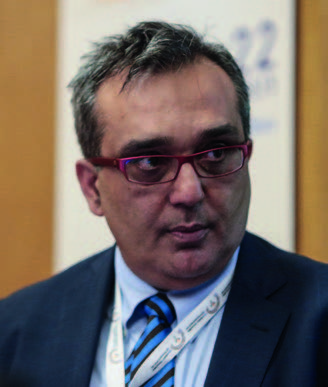"We need more neurologists and better teamwork”
on 25 April 2018 in Los Angeles by Michiel Tent
“We need more neurologists and better teamwork”
The AAN meeting is the largest neurological conference in the world, with over 14,000 attendants in Los Angeles in 2018. Exclusively for Medicom's Conference Report, AAN-president Prof. Ralph L. Sacco reflects on the meeting, the academy’s 70th anniversary, and on the challenges facing the academy and neurologists around the world.
With an overwhelming amount of research and new insights represented here, which topics would you consider to be of exceptional interest?
“It has been a phenomenal meeting with so much great new science across a broad spectrum of conditions: from new trials of medication to prevent and treat migraine, and breakthroughs in genetics and its implications for precision medicine, to important work sleep disorders and Parkinson's disease,to name but a few. There was something for everybody.
At the Presidential Session, Dr Francis Collins, director of the National Institutes of Health (NIH), emphasized the importance of precision medicine, in particular a new initiative called the 'All of Us Research Program'. Its ambitious aim is to enroll 1 million people in a cohort study, looking at genetics, biomarkers, and the evolution of neurological and other diseases. Dr Walter Koroshetz, director of the National Institute of Neurological Disorders and Stroke (NINDS), talked about the BRAIN Initiative. The BRAIN Initiative employs breakthrough technologies to better image connectivity in brain circuits, and to modify the nervous system in order to treat neurodegenerative diseases. The AAN feels strongly about this initiative and helps funding it. We also heard about the opioid crisis in the US and elsewhere: many people getting addicted to the opioids they receive as prescription medication, turning opioids into one of the largest growing causes of death in the US. The NIH now focuses on developing non-opioid pain treatments.”
Being a stroke specialist, what are the most important developments in that area?
“Stroke is a very exciting field right now. The biggest breakthrough is expanding the time window for thrombectomy. As results of the DAWN and DEFUSE-3 trials have shown, we can treat some – well-defined – patients with large-vessel occlusion up to 24 hours post acute stroke.”
What is new in the way this AAN meeting is organized?
“We continue to implement innovative changes. We still have courses and scientific sessions, but there is so much more 'bubbling' in the corridors. We call ths 'experiential learning' – there are head talks, practical work shops, 'navigating your career'-sessions for every stage in your career, you can hear about and share best practices. Then there are sessions focused on wellness of the participants: yoga, music, painting... and an incredible opening party at Universal Studio's. Who says neurologists don't know how to have a good time?”
What do you think are the biggest challenges facing the field of neurology?
“Globally, neurologists are undersupplied. In the US, for example, there is often a long delay to see a neurologist. One of the biggest challenges is training more healthcare professionals to help meet the rising demands for high-quality care. The AAN has a number of exciting programs to expand the pipeline of students choosing careers in neurology to increase the supply of future neurologists. Moreover, that's where team-based care comes into play. We want the neurologist to be the leader of that team, but there are other important members to support the team including the advanced practice provider, the physical therapist, and other subspecialists. We also aim to expand the scope of neurology practice to interventional, preventive and regenerative neurology. Traditionally, the focus has been on diagnosis, but now we have many ways to intervene. The next step is preventative neurology, which is expanding: precision medicine and biomarkers allow us to intervene in a much earlier stage. With that, we move to regenerative neurology, helping people improve their quality of life. These are therefore exciting times, with many neuroscientific breakthroughs reaching the clinic. But we need more neuroscientists and neurologists to advance this. It's a big challenge, but I think we're up to it.”
Talking about challenges: how challenging has it been for you personally, to combine the AAN presidency with your work as a neurologist and professor of neurology in Miami?
“It's not easy, but I'm part of a great team. My whole life has always been about teamwork with people I can rely on including my research and my department. Likewise, in the AAN it's not about one person: I can rely on many people including the pediatric neurologist Prof. Ann Tilton, the vice-president, and Dr Jim Stevens, the excellent president elect, and the amazing AAN staff. We're really working as a team; we 'divide and conquer'. Also, the AAN has a strategic plan: things are done in a very organized and systematic manner. All in all I can say: some days are more busy than others, but on the whole it's been fun.”
Posted on
Previous Article
« Editor Biography Next Article
Letter from the Editor »
« Editor Biography Next Article
Letter from the Editor »
Table of Contents: AAN 2018
Featured articles
Letter from the Editor
Related Articles

June 4, 2018
Letter from the Editor
© 2024 Medicom Medical Publishers. All rights reserved. Terms and Conditions | Privacy Policy
HEAD OFFICE
Laarderhoogtweg 25
1101 EB Amsterdam
The Netherlands
T: +31 85 4012 560
E: publishers@medicom-publishers.com

